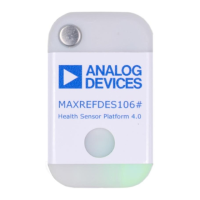©2023 Analog Devices, Inc. All rights reserved.
MAXREFDES106# Health Sensor Platform 4.0
The BioZ drive clock is generated by dividing the output of the
mux by the K Divider. The BioZ drive frequency is generated
by dividing the output of the mux by the K Divider and DAC
OSR.
The BioZ ADC Clock is generated by dividing the output of
the mux by the N Divider of the BioZ Receive. The BioZ
ADC Clock sample rate is generated by dividing the output of
the mux by the N Divider and the ADC OSR of the BioZ
Receive.
The ECG ADC Clock is generated by dividing the PLL
frequency by the F Divider and N Divider of the ECG. The
ECG ADC sample rate is generated by dividing the PLL
frequency by the F Divider, N Divider, and ADC OSR of the
ECG.
The PPG frame rate is generated by the reference clock in the
Clock Selection but is defined under the PPG Settings tab in
the Desired Frame Rate.
PPG Mode Tab
This tab controls the operating mode of the PPG AFE at a high level, and fundamentally switches the
device between two operating modes: Algorithm outputs disabled, and Algorithm outputs enabled.
The Algorithm disabled mode is used to collect raw PPG data, and the settings are controlled
manually in the PPG settings and ‘PPG Measurement Settings’ tabs instead.
The Algorithm enabled modes are used to configure the device to enable HR, SpO2, RESP, and
ICG estimation.
With algorithms enabled, a default PPG setup suitable for most situations is loaded and used as input to
the HR, SpO2, RESP, and ICG algorithms. These defaults are intelligently selected, but the evaluation
GUI offers a relatively open interface to modify the input data configuration, if necessary. However, not all
possible configurations are fully supported. If the defaults are modified, ensure the modifications are
properly selected.

